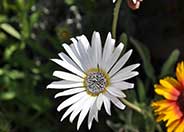
Common name:Arctotis Daisy, African Daisy
Botanical name:Arctotis grandis 'Blue Eyed Daisy
African Daisy hybrids grow 12"-18" high and 12" wide; they produce daisy-like flowers from spring through summer. These hybrids have lobed leaves and bloom in white, pink, red, purple, cream and orange.
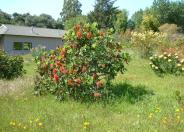
Common name:Natal bottlebrush
Botanical name:Greyia sutherlandii
Greyia sutherlandii is a large shrub or small tree, 10-20 ft high. It is deciduous and in late autumn the leaves turn shades of bright red. Young trees are compact and old trees do not grow tall but they spread and have rough, dark trunks. The leaves are simple, alternate, rather leathery, slightly lobed and coarsely toothed. The leaf surface is hairless and minutely glandular. The leaf veins radiate from the base. The leaf stalk is long and straight. The beautiful flowers are red, with oblong petals and long protruding stamens. The showy flowers open in closely packed racemes at the tips of the branches and bloom at the end of winter and early spring. The fruit is a pale brown, cone-shaped, cylindrical capsule, of 20 mm long. It splits in 4 or 5 parts when ripe to release seeds from October to December. The wood is pale pink and generally light and soft.
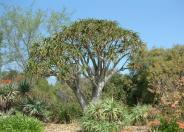
Common name:Tree Aloe
Botanical name:Aloe baineseii
This slow-growing tree has a heavy, mottled gray trunk with forking branches. It produces 2'-3' leaves in rosettes and rose/pink flowers that appear in fall or winter. This tree can reach 30' tall and 20' wide. Leaves are long, evergreen, thin, channeled, curved with toothed margins. It does best in full sun with loamy soil. Great for large containers. Deer resistant. Botanical name changed to Aloidendron barberae. Trunk can eventually reach 3' in diameter. Roots may be invasive so plant away from structures.
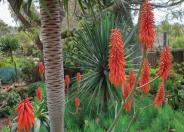
Common name: Tweekleur-aalwyn
Botanical name:Aloe cryptopoda
South African native that grows to about 4' tall and wide. Leaves are light green to glaucous green and fleshy. Yellow bloom spikes appear from January into March. Full sun to light shade, drought tolerant. As the name implies, the trunk is hidden and basically this aloe remains trunkless.
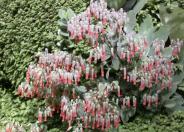
Common name:Milky Widows Thrill
Botanical name:Kalanchoe laxiflora
Kalanchoe laxiflora typically will not reach a height any taller than around 20 inches due to them being a smaller succulent species. The plant features light green leaves, except for said leaves turning more gray or white, with reddish tips. Little orange flowers can appear blooming off the leaves’ tips during the blooming season. Kalanchoe laxiflora succulents can be planted indoors or outdoors, as long as the temperatures remain safe. With that being said, a Kalanchoe laxiflora is relatively easy to care for and will rarely need attention. Kalanchoe Laxiflora succulents do work better with a specific type of soil; however, there are two ways an owner can do so. A thicker soil, such as a cacti-based soil, or coarse sand, moss, and perlite mixture will suffice. Regardless of which mixture, make sure it is well-draining soil to reduce the chances of overwatering, leading to further complications. Consistent blooming happens during the springtime when temperatures are starting to get warmer. During this time, owners will notice those orange flowers beginning to bloom right before the plant goes dormant during the summer months. Kalanchoe laxiflora requires bright sunlight conditions, whether indoors or outdoors. If your succulent is indoors, it should be placed near a well-lit window where it will receive the necessarily needed hours of sunlight daily. If the sun seems to be hitting the succulent with hot rays, move the succulent away from the window for a few hours, or hang a sheer curtain for safety precautions. These succulents flourish greatly when surrounded by warm temperatures. Specifically, temperatures ranging from 61 degrees Fahrenheit to 80 degrees Fahrenheit are vital for these succulents. Thus, temperatures above 80 degrees Fahrenheit can potentially scorch the plant’s leaves, while temperatures below 61 degrees Fahrenheit can freeze the plant. This species of succulents do not necessarily require fertilizing, as much as they appreciate it from time to time as a little boost. If you fertilize your Kalanchoe Laxiflora, it is best to use a liquid 20-20-20 mixture. This means the fertilizer possesses 20% each of potassium, nitrogen, and phosphorus.
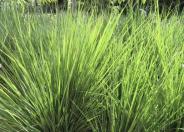
Common name:Daba Grass
Botanical name:Miscanthus capensis
Miscanthus capensisis a very hardy, evergreen, clump-forming, large grass that has beautiful autumn colors. The flowering stalks are topped with plumes of pink seed-heads in late summer and early autumn. The clumps of leaves are about 3' tall and the flowering stalks are up to 6' tall. Weavers choose this grass above other plants for nesting material. They use the leaves to weave the nest and the seed to line it. Use as a backdrop to a garden bed or as a screening plant in narrow beds. It is effective planted as a single, sculptural, feature plant in a garden. Plant into window-box type containers where they can be used as a screen on a balcony. This tall grass is beautiful moving in the lightest of breezes in the garden. As with all grasses, to keep it healthy, it should be cut back once a year and raked to remove the thatch. Plant in sun or semi-shade in damp or normal garden conditions.
Designer: UC Berkeley
Photographer: Vicki Anderson
Incorporate compost 6" into your soil to retain water, reduce compaction, feed earthworms, and provide valuable nutrients to your plants.
Remove irrigation water and fertilizer from areas where you don't want weeds to grow.